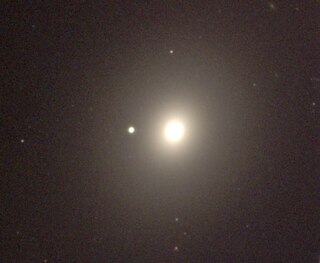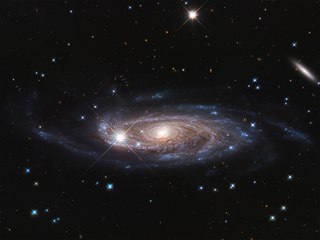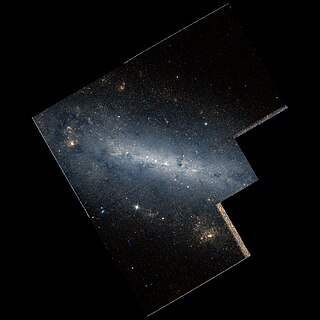The following table lists polar-ring galaxies:
The following table lists polar-ring galaxies:
| Image | Galaxy | Base galaxy type | Notes |
|---|---|---|---|
 | NGC 2685 (UGC 4666, Arp 336, Helix Galaxy) | Lenticular (S0) | [1] [2] |
 | NGC 4650A (ESO 322-IG69, AM 1241-402) | Lenticular (S0) | [2] [3] [4] |
 | NGC 660 | Lenticular (S0) or Barred Spiral (SBa) | |
| A0136-0801 | Lenticular (S0) | [2] [5] | |
| AM 1934-563 | Barred Spiral (SBa/b) | [6] | |
| ESO 415-G26 (AM 0226-320) | Lenticular (S0) | [2] [4] | |
| UGC 5119 (LEDA 27383) | Elliptical | [7] | |
| UGC 7576 | Lenticular (S0) | [2] | |
 | UGC 9796 (II Zwicky 73) | Lenticular (S0) | [2] |
| AM 2020-504 | Elliptical | [2] | |
Some galaxies feature a "polar ring" within the disk of the galaxy

Hoag's Object is an unusual ring galaxy in the constellation of Serpens Caput. It is named after Arthur Hoag, who discovered it in 1950 and identified it as either a planetary nebula or a peculiar galaxy. The galaxy has approximately eight billion stars, and is roughly 120,000 light years across.

The Sombrero Galaxy (also known as Messier Object 104, M104 or NGC 4594) is a peculiar galaxy of unclear classification in the constellation borders of Virgo and Corvus, being about 9.55 megaparsecs (31.1 million light-years) from the Milky Way galaxy. It is a member of the Virgo II Groups, a series of galaxies and galaxy clusters strung out from the southern edge of the Virgo Supercluster. It has a D25 isophotal diameter of approximately 29.09 kiloparsecs (94,900 light-years), making it slightly bigger in size than the Milky Way.

Messier 49 is a giant elliptical galaxy about 56 million light-years away in the equatorial constellation of Virgo. This galaxy was discovered by astronomer Charles Messier in 1777.

IC 1613 is an irregular dwarf galaxy, visible in the constellation Cetus near the star 26 Ceti. It was discovered in 1906 by Max Wolf, and is approaching Earth at 234 km/s.

A polar-ring galaxy is a type of galaxy in which an outer ring of gas and stars rotates over the poles of the galaxy. These polar rings are thought to form when two galaxies gravitationally interact with each other. One possibility is that a material is tidally stripped from a passing galaxy to produce the polar ring seen in the polar-ring galaxy. The other possibility is that a smaller galaxy collides orthogonally with the plane of rotation of the larger galaxy, with the smaller galaxy effectively forming the polar-ring structure.

Sextans B is an irregular galaxy that may be part of the Local Group, or lie just beyond it. Sextans B is 4.44 million light-years away from Earth and thus is one of the most distant members of the Local Group, if it is indeed a member. It forms a pair with its neighbouring galaxy Sextans A. It is a type Ir IV–V galaxy according to the galaxy morphological classification scheme. Sextans B may also be gravitationally associated with the galaxies NGC 3109 and the Antlia Dwarf.

NGC 4650A is a polar-ring lenticular galaxy located in the constellation Centaurus. It should not be confused with the spiral galaxy NGC 4650, which shares almost the same radial distance as NGC 4650A. The real distance between both galaxies is only about 6 times the optical radius of NGC 4650.

NGC 4536 is an intermediate spiral galaxy in the constellation Virgo located about 10° south of the midpoint of the Virgo cluster. However, it is not considered a member of the cluster. Rather, it is a member of the M61 Group of galaxies, which is a member of the Virgo II Groups, a series of galaxies and galaxy clusters strung out from the southern edge of the Virgo Supercluster. The morphological classification in the De Vaucouleurs system is SAB(rs)bc, which indicates it is a weakly barred spiral galaxy with a hint of an inner ring structure plus moderate to loosely wound arms. It does not have a classical bulge around the nucleus.

NGC 1134 is a spiral galaxy in the Aries constellation. It has a highly inclined disk, with respect to the line of sight from Earth. There is a weak outer extension of the spiral structure in this galaxy. It has been listed in the Arp Atlas of Peculiar Galaxies, under the "Galaxies with material ejected from nuclei" section. NGC 1134 is classified as a galaxy with reduced surface brightness, and it possesses a distinct bulge in its centre, as judged by photometric analysis. It has a small and distant companion about 7' to the south.

NGC 2397 is a flocculent spiral galaxy located in the southern Volans constellation, about one degree to the SSE of Delta Volantis. English astronomer John Herschel discovered the galaxy on February 21, 1835. It is located at a distance of approximately 69 million light years from the Sun, and is a member of the small NGC 2442 group that includes NGC 2434.

UGC 2885 is a large barred spiral galaxy of type SA(rs)c in the constellation Perseus. It is 232 million light-years (71 Mpc) from Earth and measures 463,000 ly (142,000 pc) across, making it one of the largest known spiral galaxies. It is also a possible member of the Pisces-Perseus supercluster.

UGC 9796 is a lenticular and polar-ring galaxy in the constellation Boötes, and about 250 million light years distant from Earth. It is an object of great scientific interest as there have been very few polar ring galaxies discovered. UGC 9796 is a very gas-rich environment hosting as much 5×109 solar masses of neutral hydrogen. DSS and SDSS images show that it is very similar to polar ring galaxy NGC 660, the best-known of all the polar ring galaxies.

NGC 2748 is a spiral galaxy in the northern circumpolar constellation of Camelopardalis, located at a distance of 61.3 megalight-years from the Milky Way. It was discovered September 2, 1828 by John Herschel. The morphological classification of SAbc indicates this is an unbarred spiral with moderate to loosely-wound spiral arms. It is a disk-like peculiar galaxy with a stellar shell that is rotating about the main galactic axis. This shell was most likely formed through the capture and disruption of a dwarf companion. The galactic nucleus likely contains a supermassive black hole with a mass of 4.4+3.5
−3.6×107 M☉, or 44 million times the mass of the Sun.

NGC 672 is a spiral galaxy in the northern constellation of Triangulum, positioned around 2° to the southwest of the star Alpha Trianguli. The original object designated NGC 672 was discovered by the German-born astronomer William Herschel on 26 October 1786, but this was later cataloged as NGC 614. The object now identified as NGC 672 was discovered by John Herschel on 11 November 1827.

The Coma I Group is a group of galaxies located about 14.5 Mpc (47.3 Mly) away in the constellation Coma Berenices. The brightest member of the group is NGC 4725. The Coma I Group is rich in spiral galaxies while containing few elliptical and lenticular galaxies. Coma I lies in the foreground of the more distant Coma and Leo clusters and is located within the Virgo Supercluster.
ESO 235-58 is a galaxy in the constellation of Indus.

NGC 2273 is a barred spiral galaxy located in the constellation Lynx. It is located at a distance of circa 95 million light years from Earth, which, given its apparent dimensions, means that NGC 2273 is about 100,000 light years across. It was discovered by Nils Dunér on September 15, 1867.

NGC 972 is a dusty spiral galaxy in the northern constellation of Aries, located at an approximate distance of 49.8 Mly from the Milky Way. It was discovered in 1784 by William Herschel. The galactic features suggest it may have undergone a merger with a gas-rich companion, giving it asymmetrical arms, plus starburst activity in the nucleus and an off-planar nuclear ring. The inner 3.6 kpc of the galaxy is undergoing star formation at the rate of 2.1–2.7 M☉·yr−1, but it lacks a nuclear bulge.

XY Ursae Majoris is a short period binary star system in the northern circumpolar constellation of Ursa Major. It is an eclipsing binary with a baseline apparent visual magnitude of 9.50. The system is located at a distance of 221.5 light years from the Sun based on parallax measurements, but is drifting closer with a radial velocity of −10 km/s. It has a relatively high proper motion, traversing the celestial sphere at the angular rate of 0.191″·yr−1.